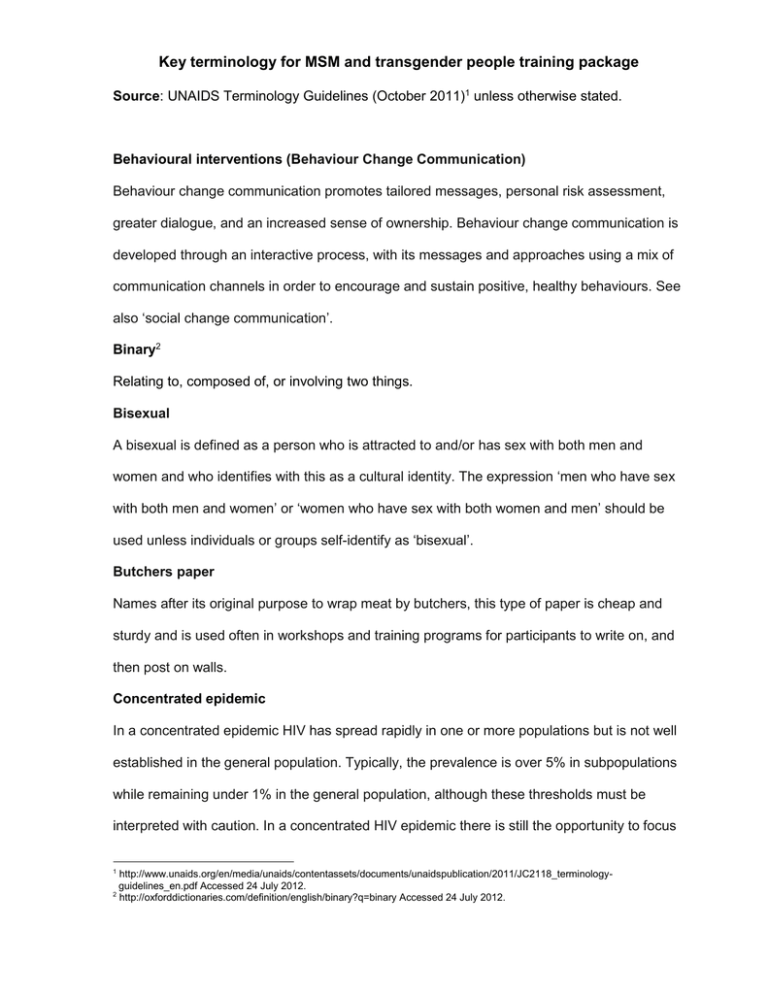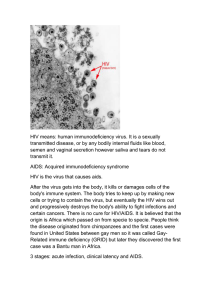
Key terminology for MSM and transgender people training package
Source: UNAIDS Terminology Guidelines (October 2011)1 unless otherwise stated.
Behavioural interventions (Behaviour Change Communication)
Behaviour change communication promotes tailored messages, personal risk assessment,
greater dialogue, and an increased sense of ownership. Behaviour change communication is
developed through an interactive process, with its messages and approaches using a mix of
communication channels in order to encourage and sustain positive, healthy behaviours. See
also ‘social change communication’.
Binary2
Relating to, composed of, or involving two things.
Bisexual
A bisexual is defined as a person who is attracted to and/or has sex with both men and
women and who identifies with this as a cultural identity. The expression ‘men who have sex
with both men and women’ or ‘women who have sex with both women and men’ should be
used unless individuals or groups self-identify as ‘bisexual’.
Butchers paper
Names after its original purpose to wrap meat by butchers, this type of paper is cheap and
sturdy and is used often in workshops and training programs for participants to write on, and
then post on walls.
Concentrated epidemic
In a concentrated epidemic HIV has spread rapidly in one or more populations but is not well
established in the general population. Typically, the prevalence is over 5% in subpopulations
while remaining under 1% in the general population, although these thresholds must be
interpreted with caution. In a concentrated HIV epidemic there is still the opportunity to focus
1
http://www.unaids.org/en/media/unaids/contentassets/documents/unaidspublication/2011/JC2118_terminologyguidelines_en.pdf Accessed 24 July 2012.
2
http://oxforddictionaries.com/definition/english/binary?q=binary Accessed 24 July 2012.
HIV prevention, treatment, care, and support efforts on the most affected subpopulations,
while recognizing that no subpopulation is fully self-contained.
Duality3
An instance of opposition or contrast between two concepts or two aspects of something (e.g.
male vs. female, masculine vs. feminine).
Enabling environment
There are different kinds of enabling environments in the context of HIV. An enabling legal
environment is one in which laws and policies against discrimination on the basis of HIV
status, risk behaviour, occupation, and gender are in place and are monitored and enforced.
An enabling social environment is one in which social norms support healthy behaviour
choices.
Gay
The term ‘gay’ can refer to same-sex sexual attraction, same-sex sexual behaviour, and
same-sex cultural identity. The expression ‘men who have sex with men’ should be used
unless individuals or groups self-identify as gay.
Gender and sex
The term ‘sex’ refers to biologically determined differences, whereas ‘gender’ refers to
differences in social roles and relations. Gender roles are learned through socialization and
vary widely within and between cultures. Gender roles are also affected by age, class, race,
ethnicity, and religion, as well as by geographical, economic, and political environments.
Moreover, gender roles are specific to a historical context and can evolve over time, in
particular through the empowerment of women. Since many languages do not have the word
‘gender’, translators may have to consider alternatives to distinguish between these two
concepts.
3
http://oxforddictionaries.com/definition/english/duality?q=duality Accessed 24 July 2012.
2
Gender identity
Gender identity refers to a person’s deeply felt internal and individual experience of gender,
which may or may not correspond with the sex assigned at birth. It includes both the personal
sense of the body, which may involve, if freely chosen, modification of bodily appearance or
function by medical, surgical, or other means, and other expressions of gender, including
dress, speech, and mannerisms.
Generalized epidemic
A generalized HIV epidemic is an epidemic that is self-sustaining through heterosexual
transmission. In a generalized epidemic, HIV prevalence usually exceeds 1% among
pregnant women attending antenatal clinics.
Heteronormative
The term ‘heteronormative’ denotes or relates to a world view that promotes heterosexuality
as the normal or preferred sexual orientation.4
Heterosexual/heterosexuality
The term ‘heterosexual’ is used to refer to people who have sex with and/or are attracted to
people of the opposite sex.
HIV/AIDS (don’t use)
The expression HIV/AIDS should be avoided whenever possible because it can cause
confusion. Most people with HIV do not have AIDS. The expression ‘HIV/AIDS prevention’ is
even more unacceptable because HIV prevention entails correct and consistent condom use,
use of sterile injecting equipment, changes in social norms, etc., whereas AIDS prevention
entails cotrimoxazole, good nutrition, isoniazid prophylaxis (INH), etc. It is preferable to use
the term that is most specific and appropriate in the context. Examples include ‘people living
with HIV’, ‘HIV prevalence’, ‘HIV prevention’, ‘HIV testing’, ‘HIV-related disease’, ‘AIDS
diagnosis’, ‘children made vulnerable by AIDS’, ‘children orphaned by AIDS’, ‘AIDS
4
Oxford English Dictionary. http://oxforddictionaries.com/definition/english/heteronormative Accessed 24 July 2012.
3
response’, ‘national AIDS programme’, ‘AIDS service organization’. Both ‘HIV epidemic’ and
‘AIDS epidemic’ are acceptable, but ‘HIV epidemic’ is a more inclusive term.
Homophobia
Homophobia is fear, rejection, or aversion, often in the form of stigmatizing attitudes or
discriminatory behaviour, towards homosexuals and/or homosexuality.
Homosexual/homosexuality
The word homosexual is derived from the Greek word ‘homos’, meaning ‘same’. It refers to
people who have sex with and/or sexual attraction to or desires for people of the same sex.
This should not be confused with the Latin word ‘homo’, which describes humanity as a
whole.
Incidence
HIV incidence (sometimes referred to as cumulative incidence) is the number of new cases
arising in a given period in a specified population. UNAIDS normally refers to the number of
adults aged 15-49 years or children (aged 0–14 years) who have become infected during the
past year. In contrast, HIV prevalence refers to the number of infections at a particular point
in time, no matter when infection occurred, and is expressed as a percentage of the
population (like a camera snapshot). In specific observational studies and prevention trials,
the term ‘incidence rate’ is used to describe incidence per hundred person years of
observation.
Intersex
An intersex person is an individual with both male and female biological attributes (primary
and secondary sexual characteristics).
Lesbian
The term ‘women who have sex with women’ should be used unless individuals or groups
self-identify as lesbians.
LGBTI
4
LGBTI is an abbreviation that covers lesbian, gay, bisexual, transsexual, transgender,
transvestite, and intersex people. Although it is preferable to avoid abbreviations when
possible, LGBTI (or LGBT) has gained recognition because it emphasizes a diversity of
sexuality and gender identities.
Low-level epidemic
The term ‘low-level epidemic’ is used for epidemics where HIV prevalence has not
consistently exceeded 1% in the general population nationally, nor 5% in any subpopulation.
Prevalence (see seroprevalence below)
Seroprevalence
As related to HIV infection, seroprevalence is the proportion of persons who have serologic
evidence of HIV infection, i.e. antibodies to HIV, at any given time.
Sexual health
Sexual health is a state of physical, emotional, mental and social well-being in relation to
sexuality; it is not merely the absence of disease, dysfunction or infirmity. Sexual health
requires a positive and respectful approach to sexuality and sexual relationships, as well as
the possibility of having pleasurable and safer sexual experiences, free of coercion,
discrimination and violence. For sexual health to be attained and maintained, the sexual
rights of all persons must be respected, protected and fulfilled.5
Sexual orientation
The term ‘sexual orientation’ refers to each person’s profound emotional and sexual attraction
to, and intimate and sexual relations with, individuals of a different, the same, or both sexes.
SOGI
Sexual Orientation and Gender Identity: see separate definitions of 'sexual orientation' and
'gender identity' above.
5
WHO. Defining sexual health: report of a technical consultation on sexual health, 28–31 January 2002. Geneva, World Health
Organization, 2006.
5
Structural Interventions
Structural interventions are those that seek to alter the physical and social environment in
which individual behaviour takes place. Their aim can also be to remove barriers to protective
action or to create constraints to risk-taking.
Transgender people
A transgender person has a gender identity that is different from his or her sex at birth.
Transgender people may be male to female (female appearance) or female to male (male
appearance). It is preferable to describe them as ‘he’ or ‘she’ according to their gender
identity, i.e. the gender that they are presenting, not their sex at birth.
Transphobia
Transphobia is fear, rejection, or aversion, often in the form of stigmatizing attitudes or
discriminatory behaviour, towards transsexuals, transgender people, and transvestites.
Treatment for Prevention (also Treatment as Prevention)
In light of recent scientific developments, new terms such as this have arisen. Treatment for
Prevention is the use of ARV treatment in a way that contributes to HIV prevention at a
population-level. It refers more specifically to the prevention benefits of antiretroviral
treatment used at the eligibility levels of WHO treatment guidelines. A concerted effort is
underway now to document these benefits in specific community settings. In 2011, early
antiretroviral treatment before an individual has reached WHO-defined treatment eligibility
was shown to reduce linked HIV transmission by 96% in serodiscordant couples. This is
coined as ‘treatment for prevention’ or “treatment as prevention”, sometimes abbreviated as
“T4P” or “TasP” respectively.
6






